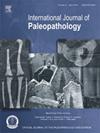从男性乳腺癌的角度看古病理学中的现世主义
IF 1.5
3区 地球科学
Q3 PALEONTOLOGY
引用次数: 0
摘要
目的通过对现代人群中临床罕见度概念的诊断价值提出质疑,并以男性乳腺癌为例,强调古病理鉴别诊断中可能存在的现代人偏见。已发表的古病理学病例报告估计人类骨骼遗骸在生物学上是男性或可能是男性,病变归因于转移性癌和多发性骨髓瘤。1909年至2017年的病例报告来自古代身体癌症研究(CRAB)数据库(n = 275),以及2018年至2023年出版物的补充文献检索。方法建立筛选标准,筛选2024年以前发表的古病理病例报告。所有确定的病例都被评估,当男性骨骼出现转移性病变时,是否在鉴别诊断中考虑乳腺癌或拒绝诊断,以及原因。结果确定了85例病例报告,其中包括估计为男性转移性病变的骨骼残骸。其中,13例病例报告在鉴别诊断中考虑了男性乳腺癌。除了一个人之外,所有人都反对这个诊断,大多数人认为现代临床罕见,很少甚至没有进一步考虑这种疾病。结论存在偏见和临床罕见的概念可能阻碍了古肿瘤学的研究,因为潜在的诊断往往没有得到充分的考虑。疾病病理学研究人员被要求重新审视他们的理论方法,并反思他们过去在疾病调查中可能存在的偏见。对未来研究的建议男性乳腺癌在古病理鉴别诊断中的进一步探讨与思考。本文章由计算机程序翻译,如有差异,请以英文原文为准。
Presentism in paleopathology, through the lens of male breast cancer
Objective
To highlight possible presentist biases within paleopathological differential diagnosis by calling into question the diagnostic value of the concept of clinical rarity in modern populations, with reference to male breast cancer as a case study.
Materials
Published paleopathological case reports of human skeletal remains estimated to be biologically male or possibly male with lesions attributed to metastatic carcinoma and multiple myeloma. Case reports from 1909 to 2017 were sourced from the Cancer Research in Ancient Bodies (CRAB) Database (n = 275), as well as a supplemental literature search for publications from 2018 to 2023.
Methods
Exclusion criteria were established to filter and identify paleopathological case reports published before 2024. All identified cases were assessed whether, when presented with metastatic lesions in the skeleton of a male, breast cancer was considered in the differential diagnosis or rejected, and the reasoning.
Results
Eighty-five case reports were identified that included skeletal remains estimated as male with metastatic lesions. Of these, 13 case reports considered male breast cancer in the differential diagnosis. This diagnosis was reasoned against by all but one, with most citing modern clinical rarity with little to no further consideration of this disease.
Conclusions
Presentism bias and the concept of clinical rarity may be hindering paleo-oncological research, as potential diagnoses are not often fully considered.
Significance
Paleopathological researchers are called on to re-examine their theoretical methodology and reflect on possible presentist biases in their investigation of diseases in the past.
Suggestions for future research
Further interrogation and consideration of male breast cancer in paleopathological differential diagnosis.
求助全文
通过发布文献求助,成功后即可免费获取论文全文。
去求助
来源期刊

International Journal of Paleopathology
PALEONTOLOGY-PATHOLOGY
CiteScore
2.90
自引率
25.00%
发文量
43
期刊介绍:
Paleopathology is the study and application of methods and techniques for investigating diseases and related conditions from skeletal and soft tissue remains. The International Journal of Paleopathology (IJPP) will publish original and significant articles on human and animal (including hominids) disease, based upon the study of physical remains, including osseous, dental, and preserved soft tissues at a range of methodological levels, from direct observation to molecular, chemical, histological and radiographic analysis. Discussion of ways in which these methods can be applied to the reconstruction of health, disease and life histories in the past is central to the discipline, so the journal would also encourage papers covering interpretive and theoretical issues, and those that place the study of disease at the centre of a bioarchaeological or biocultural approach. Papers dealing with historical evidence relating to disease in the past (rather than history of medicine) will also be published. The journal will also accept significant studies that applied previously developed techniques to new materials, setting the research in the context of current debates on past human and animal health.
 求助内容:
求助内容: 应助结果提醒方式:
应助结果提醒方式:


